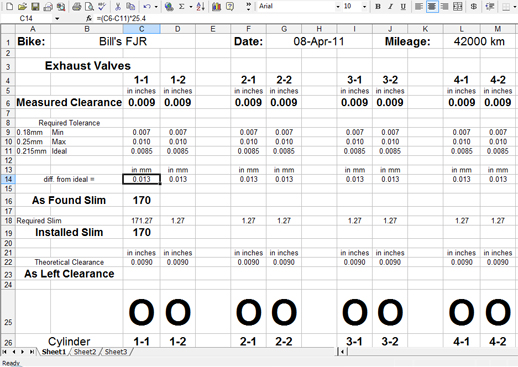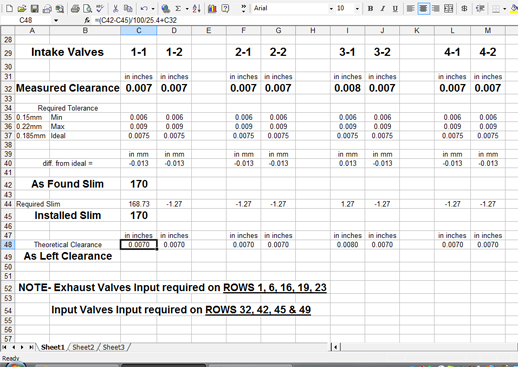TriggerT
Mr. Impatient
Did my first check this last winter at 35K miles. All within spec, with only one being every so slightly loose. Otherwise they were all dead on.


You're right. I forgot to exclude the last option of each. Thanks.Current poll standings shows you are by far in the majority. The percentage of valve checks that did NOT need any shims changed:
On the first check is 81% , and the second check is 79%.
Cool. It might be in 2012 when I can get the next one done.You got it, Bubba!! No go vote!!Hey Fred,I need options for the 3rd, 4th and 5th valve checks.









Fred, just saw this, and the data is very interesting to me. Thanks for putting it together.The most interesting statistic:
Of the checks done by dealers, adjustment was required <i>only 18%</i> of the time.
Conversely, of the checks done by owners, adjustment was determined to be required <i>37% of the time</i>.
Conclusions: Both numbers of required re-shims are low, but you might conclude that, either the owners doing their own checks are more fastidious about it (false negatives occurring at the dealers), or the owners don't know what they are doing and incorrectly re-shim when it's not really needed (false positives in their tests).
I agree. There's a reason they call them "feeler" gauges, and it's called that because of the subjectivity of having to "feel" what a particular gap is like. That said, I would also agree that the primary error when using feeler gauges is to (incorrectly) gauge the gap larger than it actually is. Since valves really only wear where they become tighter, this would result in not re-shimming a gap that is actually tighter than spec. So neophyte feeler gauge users should err that way.Also, there is lots of gauge R&R error and variables with feeler gauges, and owner's might be double-checking (I would roll the engine over again and re-check, just me being anal). And, it might be easier to think a gap is bigger rather than smaller. Very dependent on the skill and care of the individual.
We'll have to discuss more with Fred. I would have thought the common error would be to call a gap too small, as it should be harder to put a "too big" feeler in. That's why I would re-spin the engine over and remeasure... in case the gap grew... other things come into play too if you don't stop in the same position or things seat differently on the second spin.. I don't worry about a thou. but I like to look for repeatability in the reading I got. Spin a third time if need be (notice how my way will take longer!!). I would re-shim to the loose side also, as the gaps should be tighter with wear.Crap, you guys are making me doubt myself here!! I just went through a shim check and all but 3 were over (on the tight side) the 3 in question were right on the upper limit. I always thought you re-shim to the "loose side" as valves will wear in the seat and thus will result in a tighter limit as the valve lifts in the shaft. Am I wrong here?? or have I just ordered all the wrong shims?? Good thing I haven't actually buttoned it back up yet.
HELP????
https://www.fjrforum.com/forum//index.php?showtopic=130091&view=findpost&p=756344[devil's advocate]Also, there is lots of gauge R&R error and variables with feeler gauges, and owner's might be double-checking (I would roll the engine over again and re-check, just me being anal). And, it might be easier to think a gap is bigger rather than smaller. Very dependent on the skill and care of the individual.
Let me put it this way:
Compare the number of times a re-shim is done (incorrectly) and it results in engine issues (either minor, correctable running issues, or massive engine damage) with the number of engines that have had issues of any kind due to overly worn valves.
[/devil's advocate]
Yes, that (bolded sentence) is what I was saying too. If an error in measurement was being made it would be that the gap was being called as being smaller than it actually is because the checker wasn't able to get the feeler in.We'll have to discuss more with Fred. I would have thought the common error would be to call a gap too small, as it should be harder to put a "too big" feeler in. That's why I would re-spin the engine over and remeasure... in case the gap grew... other things come into play too if you don't stop in the same position or things seat differently on the second spin.. I don't worry about a thou. but I like to look for repeatability in the reading I got. Spin a third time if need be (notice how my way will take longer!!). I would re-shim to the loose side also, as the gaps should be tighter with wear.Crap, you guys are making me doubt myself here!! I just went through a shim check and all but 3 were over (on the tight side) the 3 in question were right on the upper limit. I always thought you re-shim to the "loose side" as valves will wear in the seat and thus will result in a tighter limit as the valve lifts in the shaft. Am I wrong here?? or have I just ordered all the wrong shims?? Good thing I haven't actually buttoned it back up yet.
HELP????
Thoughts Fred or did I misinterpret?
Thanks for the advice guys! That was my thought anyways, and I did spin the motor probably 5-6 times to verify my measurements......on two separate occasions. Now I'm just waiting for my order to show up so I can start re-assembling......now I just need to start looking for a used GENII rear shock (should've pulled the trigger on one of the few I saw in the past few months.....) :huh: I will spin them and re-check the new shim clearance before I hook up the chain.Yes, that (bolded sentence) is what I was saying too. If an error in measurement was being made it would be that the gap was being called as being smaller than it actually is because the checker wasn't able to get the feeler in.We'll have to discuss more with Fred. I would have thought the common error would be to call a gap too small, as it should be harder to put a "too big" feeler in. That's why I would re-spin the engine over and remeasure... in case the gap grew... other things come into play too if you don't stop in the same position or things seat differently on the second spin.. I don't worry about a thou. but I like to look for repeatability in the reading I got. Spin a third time if need be (notice how my way will take longer!!). I would re-shim to the loose side also, as the gaps should be tighter with wear.Crap, you guys are making me doubt myself here!! I just went through a shim check and all but 3 were over (on the tight side) the 3 in question were right on the upper limit. I always thought you re-shim to the "loose side" as valves will wear in the seat and thus will result in a tighter limit as the valve lifts in the shaft. Am I wrong here?? or have I just ordered all the wrong shims?? Good thing I haven't actually buttoned it back up yet.
HELP????
Thoughts Fred or did I misinterpret?
Just jamming a feeler gauges into the gap is a go/no-go situation of sorts. If you can't get the .006" feeler in on the intake, or the .007" in the exhaust, then the gap is tighter than spec. If you can get it in there, it is OK. You'd be hard pressed to force open a valve against its spring just pushing on the end of a .007" thick feeler.
And Matt, I agree with your thinking. If I was going to remove the cam for re-shimming I would shoot for the wider end of spec as that will give you the longest time before the next adjustment is needed. The range of the spec is tight enough that the engine will run perfectly fine anywhere in that range.
Just make sure no piston is at TDC when you manually spin that cam! It's bad enough if the motor creates its own "Interference Test".I will spin them and re-check the new shim clearance before I hook up the chain.


Yep - something like 6 had to be changed.BikerGeek's bike had 72000 miles but Andy had never done the valve checks since he has owned the bike (an '03 bought used). Andy's bike was out of spec on a number of valves and had shims changed out to bring everything back in line.